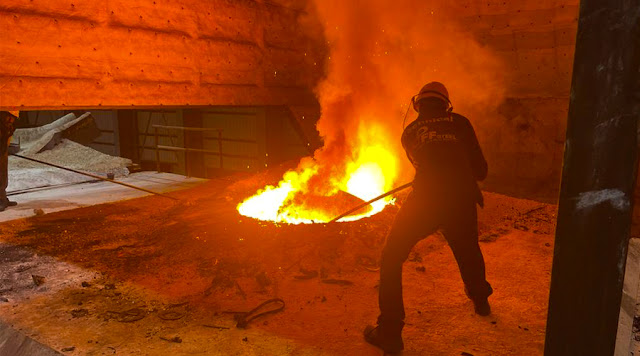Induction Furnace Working Principle
What is the induction furnace working principle ?
As we know, an induction furnace is an electric furnace used to melt metals.
There are three types of AC power used in induction furnaces: power frequency (50 Hz or 60 Hz), intermediate frequency (60-10000 Hz) and high frequency (higher than 10000 Hz).
Induction furnaces are divided into two types: induction melting furnaces and induction heating equipment. The former is used for smelting or heat preservation of materials, and the charge is finally in a liquid state; the latter is used for heating materials, including overall uniform heating, surface heating or local heating of materials.
Induction Furnace Working Principle
In an induction furnace, there is an induction coil that, when energized with an alternating current, creates an alternating magnetic field. The metal charge to be heated is placed in an alternating magnetic field, and an electric current is generated in the metal charge due to electromagnetic induction. Due to the resistance of the metal charge, the metal charge will be heated when the current passes through it. The induction furnace mainly uses this heat to heat and melt the metal charge.
To carry out induction heating, two basic conditions must be met: the first is to use alternating current; the second is that the object to be heated must be a metal material. In an induction furnace, the power transmitted to the metal charge is proportional to the resistivity of the metal charge, and the heating effect of high resistivity metal materials (cast iron, steel, etc.) is better than that of low resistivity metal materials (such as copper, aluminum); ferromagnetic materials It has a better heating effect than non-ferromagnetic materials.
The induction furnace working principle of the intermediate frequency furnace:
According to the basic principle of electromagnetic induction, the intermediate frequency electric furnace rectifies the three-phase power frequency alternating current into direct current, and then converts the direct current into an adjustable intermediate frequency current to supply the load composed of capacitor and induction coil (coil and capacitor can be connected in parallel or series), generate high-density magnetic force lines in the induction coil, and cut the metal material contained in the induction coil, generating a large eddy current in the metal material.
This eddy current also has some properties of the intermediate frequency current, that is, the free electrons of the metal itself flow in the metal body with resistance to generate heat.
For example, if a metal cylinder is placed in an induction coil with an alternating intermediate frequency current, the metal cylinder is not in direct contact with the induction coil, and the temperature of the energized coil itself is already very low, but the surface of the cylinder is heated to red, or even melted. , and this speed of redness and melting can be realized only by adjusting the frequency and the strength of the current. If the cylinder is placed in the center of the coil, the temperature around the cylinder will be the same, and the heating and melting of the cylinder will not produce harmful gases or pollute the environment with strong light.
Induction Furnace Features
(1) Electromagnetic induction heating.
(2) There is a certain intensity of electromagnetic stirring in the molten pool.
(3) The specific surface area of the molten pool is small.
(4) The input power is easy to adjust.
(5) The same power supply can supply power to several furnace bases with different capacities (but not at the same time), so in terms of smelting capacity, induction furnaces are more flexible than electric arc furnaces.
(6) High thermal efficiency.
(7) Less smoke and dust, less pollution to the environment.
(8) The refractory material consumption is higher than that of the electric arc furnace, and the life of the crucible is short.
The application of induction furnace has brought cast iron production into a new stage, and it is also showing a new trend of growth in the metal smelting industry. The above is about induction furnace working principle, I hope it will be helpful to you.
For more knowledge about induction furnaces, SAF, EAF, LF and other smelting furnaces, please continue to pay attention to my blog.
Please feel free to contact us for any needs.
E-mail: saleswn@hanrm.com / inquiry66@hanmetallurgy.com
Xi'an Hani Tech Co., Ltd.



Comments
Post a Comment